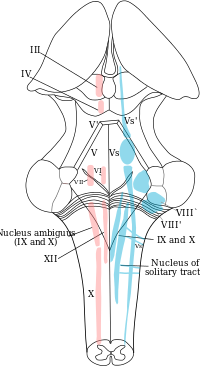The TMJ is innervated by branches of the mandibular division of the Trigeminal Nerve – CNV .
 The anterior and medial parts by the deep temporal nerve and the masseteric nerve
The anterior and medial parts by the deep temporal nerve and the masseteric nerve
 The posterior and lateral parts are innervated by the auriculotemporal nerve.
The posterior and lateral parts are innervated by the auriculotemporal nerve.
The second nerve in the pathway connects to the trigeminal nucleus which extends into the upper cervical spine .
This location permits dysfunction in the upper cervical spine (C1-3 or some say C1-5) to affect the TMJ. The opposite can apply as well.
Dr. Cohen stated that 70% of the time TMJ and upper cervical dysfunction occur simultaneously . In fact, dysfunction in one can halt pain progression in the other, especially due to the trigeminal nucleus’ susceptibility towards hypersensitization to pain. So if you ever have a cervical or TMJ patient not progressing like you’d expect, check the opposing joint!

 The anterior and medial parts by the deep temporal nerve and the masseteric nerve
The anterior and medial parts by the deep temporal nerve and the masseteric nerve